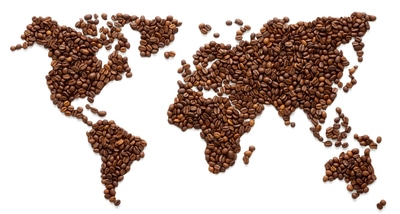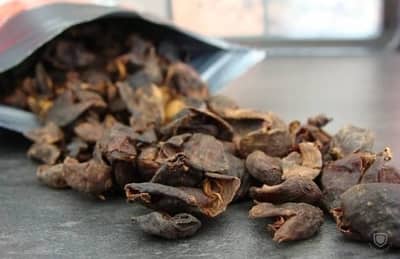25 Top Coffee-Producing Countries in 2025
Coffee ranks as the second most traded commodity on the planet, with producers generating more than nine billion kilograms (19 billion pounds) annually.[1] We’ve put together a list of the world’s top 25 coffee-producing countries producing arabica and robusta coffee beans.
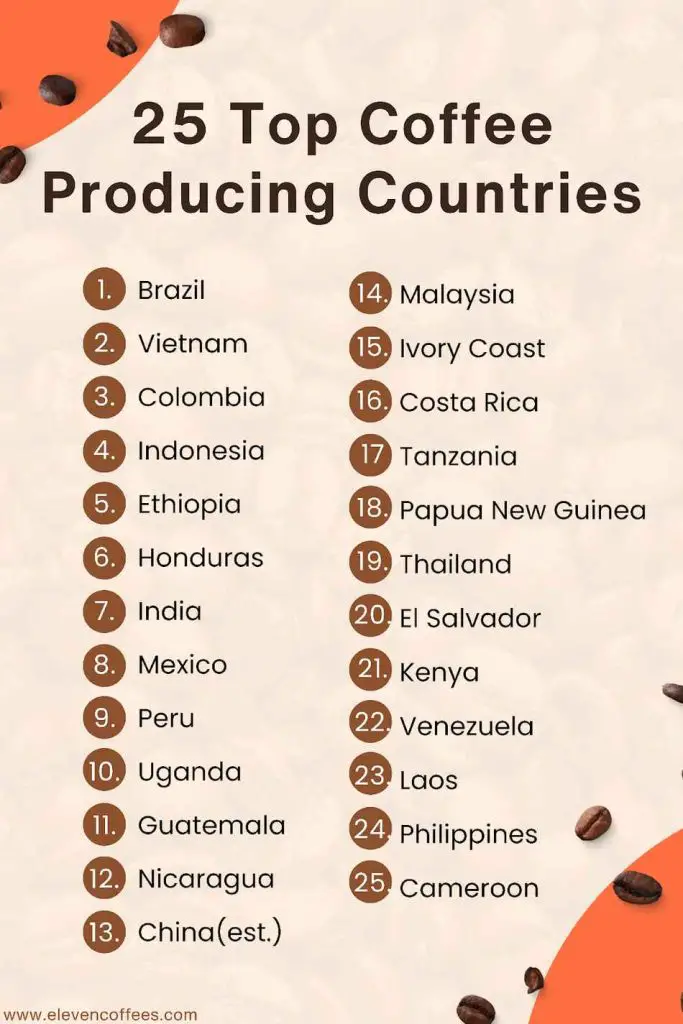
There’s been a lot of change in recent years as coffee production increases or decreases by country. Here’s a breakdown of the numbers with extra data on arabica and robusta production.
1. Brazil

Brazil is the world’s largest coffee producer. Producing 3,558,000 metric tons (7,844,000,000 pounds) of coffee, Brazil accounts for around one-third of the world’s coffee.
Arabica makes up 69% of Brazilian coffee, with robusta making up the remaining 31%.
The main growing regions for arabica are on the eastern side of Brazil running from Fortaleza in the north, down to its border with Uruguay in the south. The main production of robusta is in the state of Rondônia at the border with northern Bolivia.
Notable coffee-producing regions: Bahia, Cerrado do Bahia, Chapada de Minas, Chapada Diamantina, Espiritu Santo, Matas de Minas, Mato Grosso, Mato Grosso do Sul, Minas Gerais, Paraná, Planalto de Bahia, Sao Paulo, and Sul de Minas.
2. Vietnam

Vietnam is the world’s second-largest coffee producer. Producing 1,830,000 metric tons (4,034,000,000 pounds), Vietnam accounts for 17% of the world’s coffee.
Robusta makes up around 95% of Vietnamese coffee, with arabica making up the remaining 5%.
Growing regions span the entire country, with farmers predominantly producing robusta in the south and arabica in the north.
Notable coffee-producing regions: Central Highlands, North Vietnam, and South Vietnam.
3. Colombia

Colombia is the world’s third-largest coffee producer. Producing 858,000 metric tons (1,892,000,000 pounds), Colombian coffee accounts for 8% of the world’s coffee.
Colombia only produces the arabica variety*. In fact, it’s actually the second highest producer of arabica in the world.
Coffee is mainly produced in the west of the country, stretching from its border with Ecuador in the south to the border with Venezuela in the north.
Notable coffee-producing regions: Antioquia, Caldas, Cauca, Cundinamarca, Huila, Nariño, Norte de Santander, Sierra Nevada, Quindio, Risaralda, Santander, Tolima, and Valle del Cauca.
4. Indonesia

In fourth place is Indonesia, which produces 642,000 metric tons (1,415,000,000 pounds) of coffee. Indonesia accounts for 6% of the world’s coffee.
The islands produce both arabica and robusta. Robusta makes up 91% of the production, with the remaining 9% being arabica.
Coffee is produced extensively throughout the islands. The arabica variety is grown in New Guinea and can be found throughout the country. Robusta is predominantly produced in central Borneo. As for the rest of the islands, the production is a mix of arabica and robusta.
Notable coffee-producing regions: Bali, Flores, Java, New Guinea, Sulawesi, and Sumatra.
5. Ethiopia

Next up is Ethiopia, the first of the African coffee-producing nations. Ethiopia produces 441,000 metric tons (972,000,000 pounds) of coffee, making for 4% of the world’s total coffee.
All of the coffee produced in Ethiopia is of the superior arabica variety.
Coffee is produced mainly to the west of Ethiopia but also in the central region east of the capital, Addis Ababa.
Notable coffee-producing regions: Gimbi, Harrar, Jima, Limu, Sidama, and Yirgacheffe.
6. Honduras

In sixth place is the first of the Central American countries, Honduras. Honduras produces 390,000 metric tons (860,000,000 pounds) of coffee. That figure means Honduras provides the world with 3.6% of the world’s coffee.
All of the coffee produced in Honduras is of the arabica variety.
The bulk of the coffee-growing regions is towards the west of the country with the most concentrated areas being at the border with El Salvador in the west and the surrounding area of the capital, Tegucigalpa.
Notable coffee-producing regions: Agalta, Comayagua, Copán, El Paraíso, Montecillos, and Opalaca.
7. India

India is next as another major coffee-producing nation in Asia. This country produces 329,100 metric tons (726,000,000 pounds) of coffee. That accounts for 3% of the global coffee output.
In India, arabica and robusta are both produced, but robusta dominates production at 73%, with arabica making up the remaining 27%.
Coffee-growing regions are spread throughout the lower half of India, with production being a mix of arabica and robusta.
Notable coffee-producing regions: Andhra Pradesh, Bababudangiri, Chikmagalur, Coorg, Karnataka, Kerala, Manjarabad, Nilgiri, Pulney, Shevaroy, Tamil Nadu, Travancore, and Wayanad.
8. Mexico

The only North American country to produce coffee in the world’s top 25 is Mexico. Producing 273,000 metric tons (602,000,000 pounds) sees Mexico climbing higher up the ranks in the top 25. Mexico’s production accounts for 2.5% of the world’s coffee.
Almost all the coffee produced in Mexico is of the arabica variety at 96%, with the remaining 4% being the inferior robusta variety.
Coffee grows in the lower half of Mexico. The main growing regions are along the Pacific coast, the Gulf of Mexico, and at the border with Guatemala and Belize.
Notable coffee-producing regions: Chiapas, Oaxaca, and Veracruz.
9. Peru

Another to climb up the ranks is Peru in ninth place. Peru produces 270,000 metric tons (595,000,000 pounds) of coffee, accounting for 2.4% of the world’s coffee.
All the coffee grown in Peru is of the superior arabica variety.
Coffee grows extensively across the country from the north-western border with Ecuador, right through the central regions and onto the southern border with Bolivia.
Notable coffee-producing regions: Cajamarca, Cusco, Junin, and San Martin.
10. Uganda
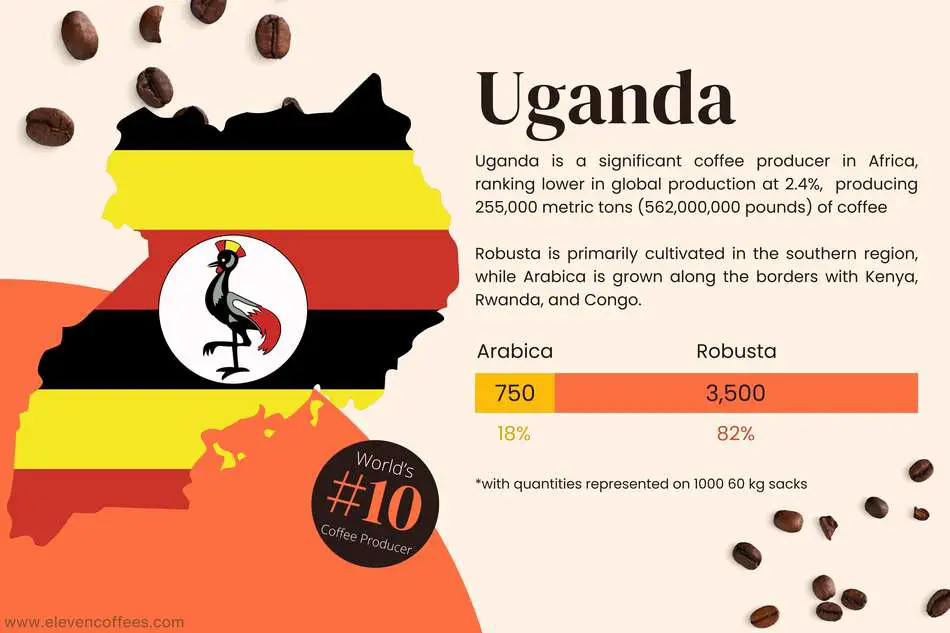
Another of Africa’s major coffee-producing nations is Uganda. Producing 255,000 metric tons (562,000,000 pounds) of coffee see Uganda fall a few places. Uganda’s production provides 2.4% of the total output of global coffee.
The bulk of coffee production is robusta at 82%, and arabica accounts for the rest at 18%.
Ugandan robusta production is spread throughout the southern region with some production in the north. Arabica is found around the borders with Kenya to the east, Rwanda to the southwest, and Congo in the western and northern areas.
Notable coffee-producing regions: Bugisu, Central Lowlands, Western Uganda, and West Nile.
11. Guatemala
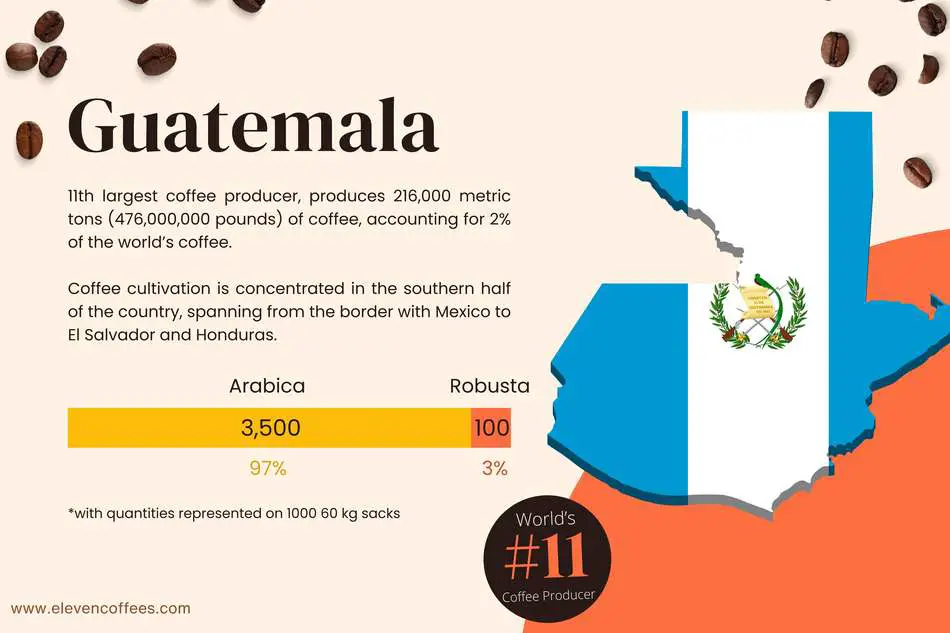
Sliding down the ranks in eleventh place is Guatemala in Central America. Guatemala produces 216,000 metric tons (476,000,000 pounds) of coffee, accounting for 2% of the world’s coffee.
Production is mostly arabica, totalling over 97% of its coffee production, with less than 3% being of the robusta variety.
Coffee is grown in the lower half of the country with the most concentrated area being in the south from its border with Mexico to El Salvador and Honduras.
Notable coffee-producing regions: Acatenango, Antigua, Atitlán, Cobán, Fraijanes, Huehuetenango, Nuevo Oriente, and San Marcos.
12. Nicaragua

Another major coffee-producing nation in Central America is Nicaragua. Producing 140,400 metric tons (310,000,000 pounds) of coffee, Nicaragua accounts for 1.3% of the world’s coffee.
Almost all of the coffee grown in Nicaragua is of the arabica variety, totalling 98%; however, in recent years a very small yield of robusta of just 2% is being produced annually.
Main growing regions are in the western half of Nicaragua, from its border in the north with Honduras through the central regions and on down to the northern tip of Lake Cocibolca.
Notable Growing regions: Jinotega, Matagalpa, and Nueva Segovia.
13. China

Famed for its tea, next on the list is somewhat of a surprise. Producing 138,000 metric tons (304,000,000 pounds) of arabica coffee, China accounts for 1.3% of the world’s arabica and a growing influence in the world of coffee-producing nations.
China produces both arabica and robusta. Unfortunately, there is not enough data to provide accurate quantities of robusta. Figures given are estimates only.
Growing regions are in the south of the country with Pu’er, in the Yunnan province, accounting for 60% of the country’s total output.[2]
Notable coffee-producing regions: Fujian, Hainan, and Yunnan.
14. Malaysia

Malaysia is up next producing 120,000 metric tons of coffee. Malaysian coffee accounts for 1.1% of the planet’s total coffee output.
All of the coffee produced in Malaysia is of the robusta variety.
Farmers produce coffee throughout the Malaysian peninsula and at the northernmost tip of East Malaysia (Malaysian Borneo).
Notable coffee-producing regions: Kedah, Kelantan, Malacca, Sabah, Sellangore, and Trengganu.
15. Ivory Coast
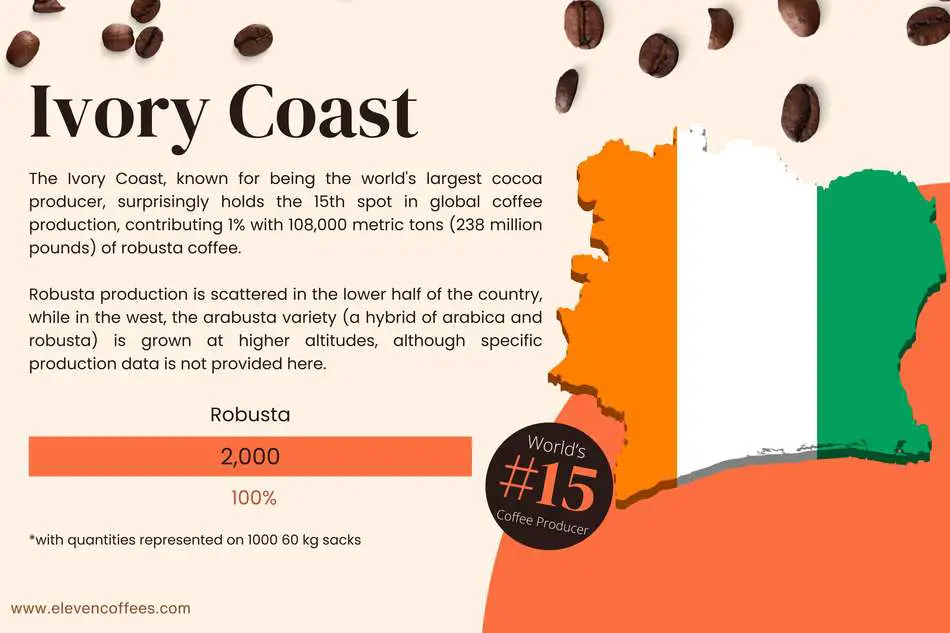
The Ivory Coast (or Côte d’Ivoire) comes in at fifteenth place and is probably another surprise to coffee drinkers as it’s known as the world’s largest producer of cocoa. The Ivory Coast produces 108,000 metric tons (238,000,000 pounds) of coffee. That’s 1% of the world’s coffee.
All coffee produced in the Ivory Coast is of the inferior robusta variety.
Production of robusta is scattered around the lower half of the country.[3 (pdf)]
Interestingly, farmers produce the arabusta variety, a hybrid of arabica and robusta, in the west of the country due to the higher altitudes found there.4] This article does not include data on arabusta production.
Notable coffee-producing regions: Abengourou, Abboisso, Divo, and Western Highlands (arabusta).
16. Costa Rica
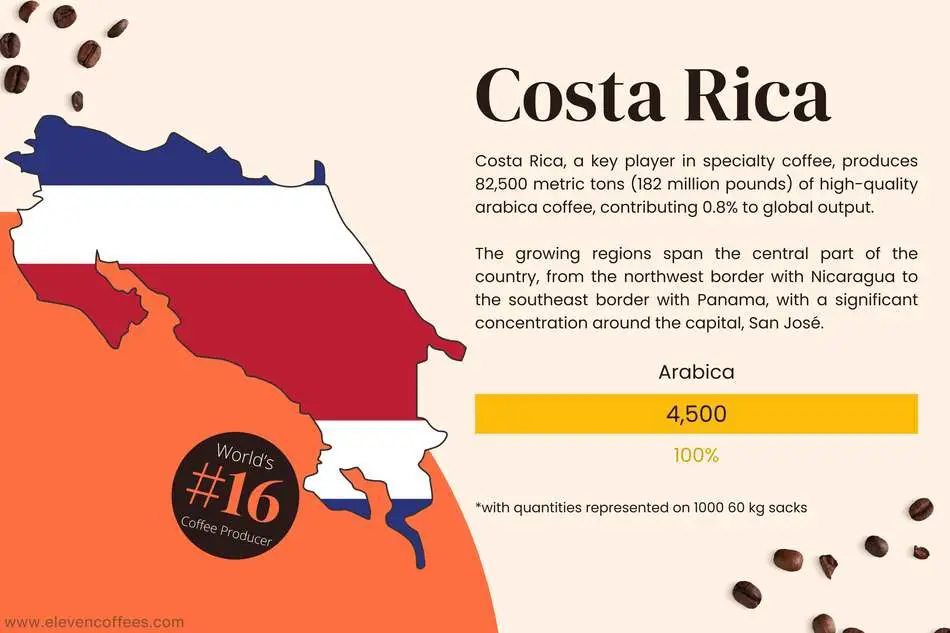
Next up is a familiar face in the specialty coffee industry and one of my favourites, Costa Rica. The country produces 82,500 metric tons (182,000,000 pounds) of coffee, making up 0.8% of the globe’s coffee.
All of the coffee grown in Costa Rica is of the superior arabica variety.
Growing regions are mainly spread through the centre of the country from the north west at the border with Nicaragua to the south east at the border with Panama. The biggest concentration being in the centre surrounding the capital San José.
Notable coffee-producing regions: Brunca, Central Valley, Guanacaste, Orosi, Tarrazú, Tres Rios, Turrialba, and West Valley.
17. Tanzania

Tanzania is another large producer of coffee from Africa and another to climb up the rankings into sixteenth place. Producing 75,000 metric tons (165,000,000 pounds) of coffee means Tanzania accounts for 0.7% of the world’s coffee.
Producers grow both arabica and robusta in almost equal quantities, with arabica slightly edging ahead at 52% and robusta accounting for the remaining 48%.
Growing regions for arabica tend to be located around Tanzania’s borders with the other African producing nations. Inland regions that produce arabica coffee are located east and south of the capital, Dodoma. Robusta is produced in the north near the border with Uganda and Rwanda.
Notable coffee-producing regions: Arusha, Kigoma, Kilimanjaro, Mbeya, Ruvuma, and Tarime.
18. Papua New Guinea
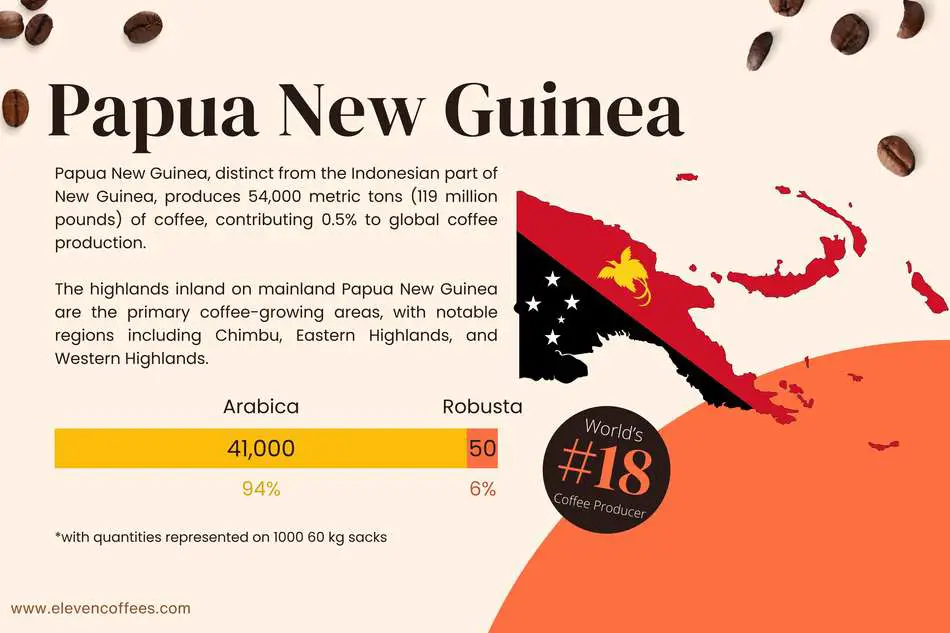
Up next is Papua New Guinea (not to be confused with New Guinea of Indonesia). Producing 54,000 metric tons (119,000,000 pounds) of coffee, Papua New Guinea accounts for 0.5% of the world’s coffee.
The country produces both arabica and robusta. Arabica accounts for 94%, with robusta accounting for the remaining 6%.
Coffee grows inland centrally on mainland Papua New Guinea in the highlands.
Notable coffee-producing regions: Chimbu, Eastern Highlands, and Western Highlands.
19. Thailand

Another that is climbing up the ranks and comes as somewhat of a surprise is Thailand. Producing 42,000 metric tons (93,000,000 pounds) of coffee means Thailand supplies the planet with almost 0.4% of its coffee.
All of the coffee produced in Thailand is of the inferior robusta variety.
Coffee in Thailand grows in the northwest of the country at the border with Malaysia, and also in the southern strip that runs between the Andaman Sea and the Gulf of Thailand.
Notable coffee-producing regions: Chiang Mai, Chiang Rai, Lampang, Chumphon, Krabi, Mae Hong Son, Nakhon, Phang Nga, Ranong, Si Thammarat, Surat Thani, and Tak.
20. El Salvador
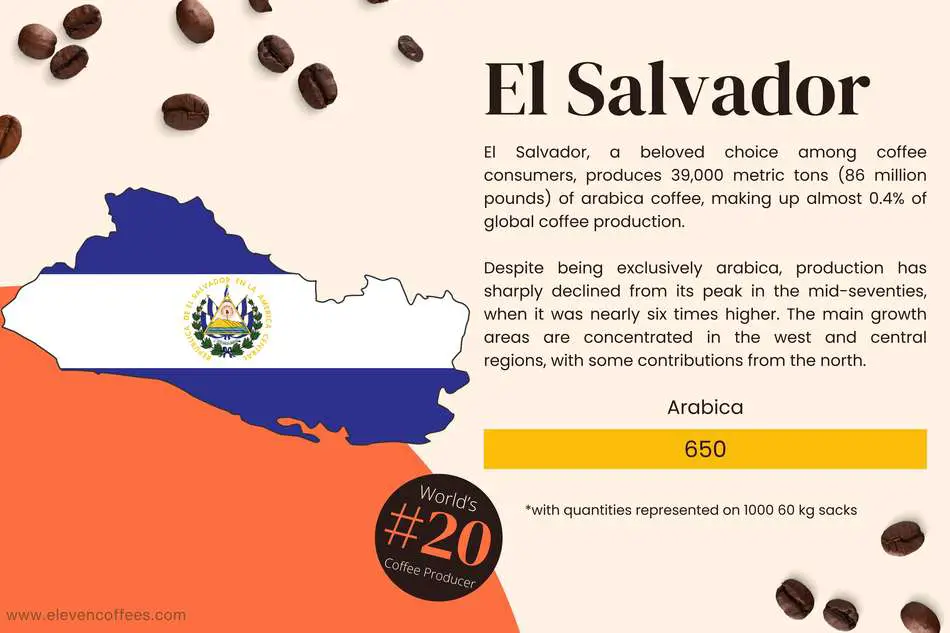
Another Central American country that is very popular among consumers is the country of El Salvador, producing 39,000 metric tons (86,000,000 pounds) of coffee. That accounts for almost 0.4% of the world’s coffee.
All of the coffee produced is of the arabica variety; however, the production of coffee has fallen significantly since the period between 1970 – 1990. At its peak in the mid-seventies, El Salvador produced almost six times as much coffee as it does today.
The most concentrated areas of growth are in the west with production running through the middle of the country. Some areas to the north also produce coffee.
Notable coffee-producing regions: Alotepec-Metapan mountain range, Apaneca-Ilamatepec mountain range, Cacahuatique mountain range, Chinchontepec volcano, El Bálsamo-Quezaltepec mountain range, and Tepeca-Chinameca mountain range.
21. Kenya

Next up is Kenya, a favourite of many coffee drinkers. Kenya also produces 39,000 metric tons (86,000,000 pounds) of coffee, accounting for almost 0.4% of the world’s coffee.
All of the coffee produced in Kenya is arabica. The total coffee output of Kenya today is almost a quarter of what it was in the ’80s and ’90s.
The main regions that grow coffee in Kenya are in the southwestern part of Kenya, namely the area to the east and north of Nairobi, and towards the east at the border with Uganda.
Notable coffee-producing regions: Embu, Kiambu, Kirinyaga, Kisii, Machakos, Meru, Murang’a, Nakuru, Nyeri, and Trans-Nzoia (Keiyo & Marakwet)
22. Venezuela
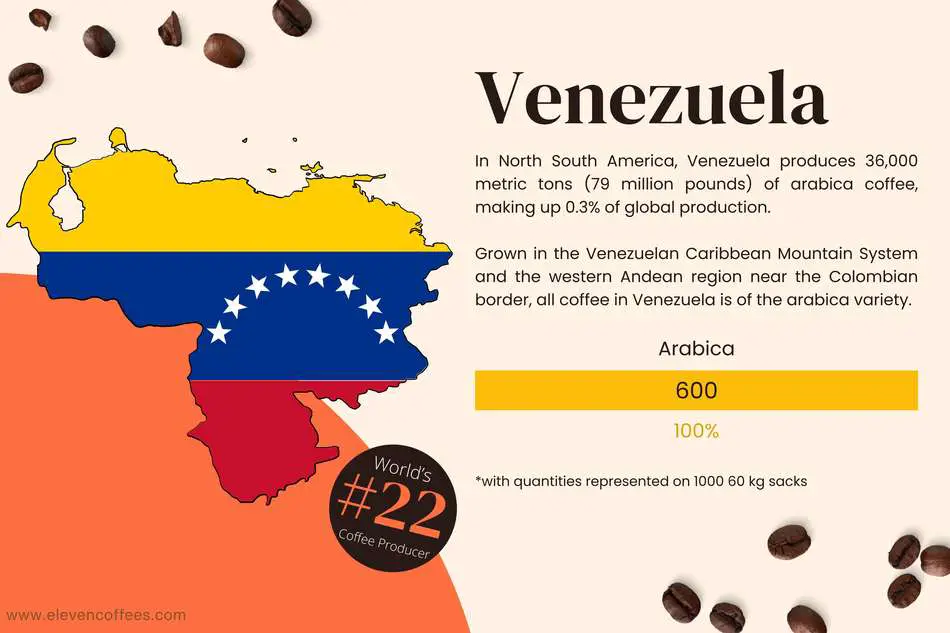
In the very north of South America sits Venezuela producing 36,000 metric tons (79,000,000 pounds) of coffee. That output accounts for 0.3% of the globe’s coffee.
All of the coffee produced in Venezuela is of the arabica variety.
Coffee is produced in the Venezuelan Caribbean Mountain System in the north, and also in the western Andean region towards the border with Colombia.
Notable growing regions: Anzoátegui Aragua, Bolivar, Carabobo, Cojedes, Falcón, Guárico, Lara, Mérida, Miranda, Monagas, Portuguesa, Sucre, Táchira, Yaracuy, and Zulia.
23. Laos
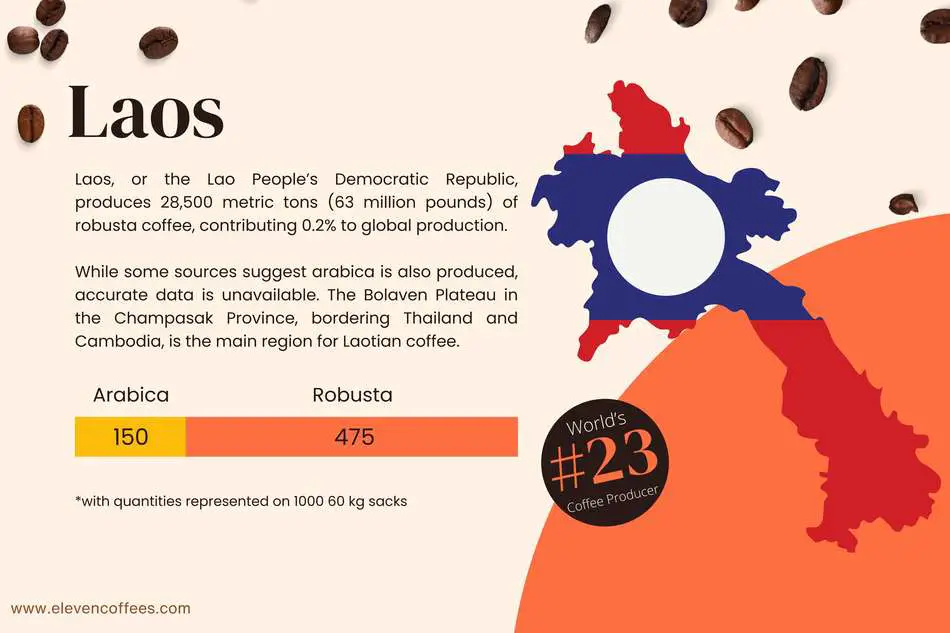
Another producer of coffee in Asia is Laos (or Lao People’s Democratic Republic). Producing 28,500 metric tons (63,000,000 pounds) of robusta coffee means that Laos supplies the world with 0.2% of its coffee.
According to one source, arabica is produced alongside robusta[3]; however, there is not enough information to provide accurate data. They did not take data for arabica into account in Laos’s overall ranking.
Farmers produce the vast majority of Laotian coffee in the Bolaven Plateau in the Champasak Province, near the borders with Thailand and Cambodia, in the south of the country.
Notable coffee-producing region: Bolaven Plateau.
24. Philippines

Moving up several places from recent years is the Philippines. Its production of 27,000 metric tons (60,000,000 pounds) of coffee means that 0.2% of the world’s coffee is coming from the Philippines.
Production of robusta dominates at 94%, with arabica making up just 6%.
Farmers grow coffee on many of the major islands that make up the Philippines.
Notable coffee-producing regions: Calabarzon, Cordillera Administrative Region, Mimaropa, Mindanao, and Visayas.
25. Cameroon
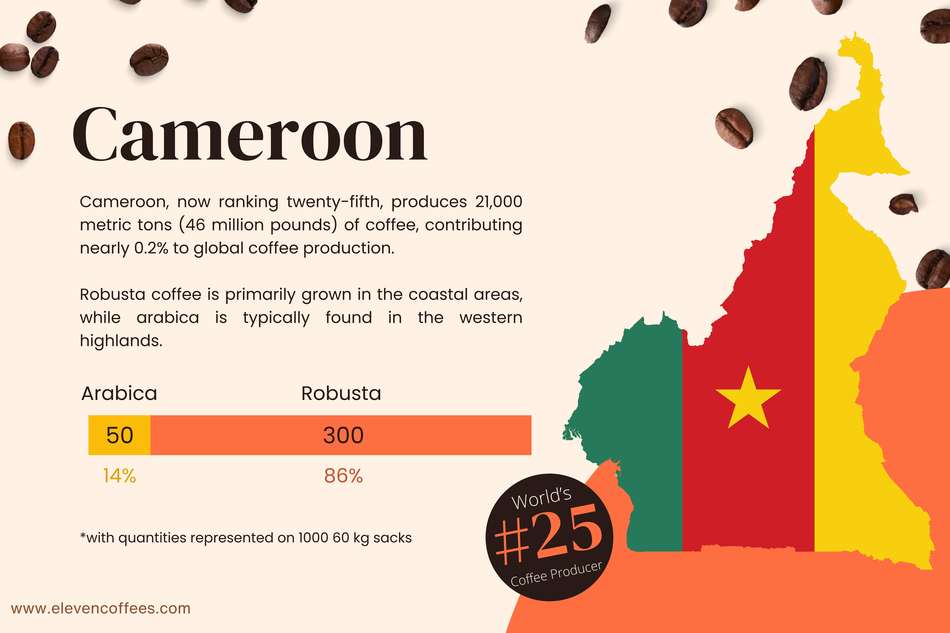
Down several places from recent years, but just narrowly pipping Rwanda to take the twenty-fifth spot is the African nation of Cameroon. Producing 21,000 metric tons (46,000,000 pounds) of coffee, Cameroon provides the planet with almost 0.2% of its coffee.
Cameroon produces both robusta and arabica. Robusta makes up 86%, with arabica making up the remaining 14%.
Farmers mostly grow robusta coffee in the coastal areas of Cameroon, while they usually cultivate arabica in the western highlands.
Notes
*Production of a coffee variety is considered zero if it’s below 1000 60kg (132lbs) sacks annually.
References
Information for this article was sourced from:
- Data sourced from Index Mundi.
- The World Atlas of Coffee (2nd ed.) by James Hoffmann.

